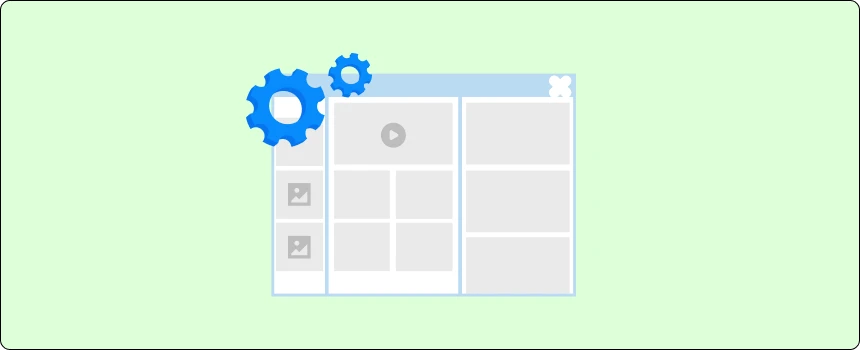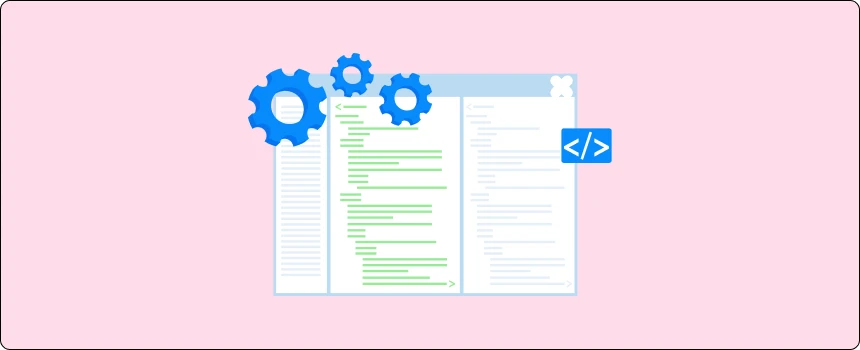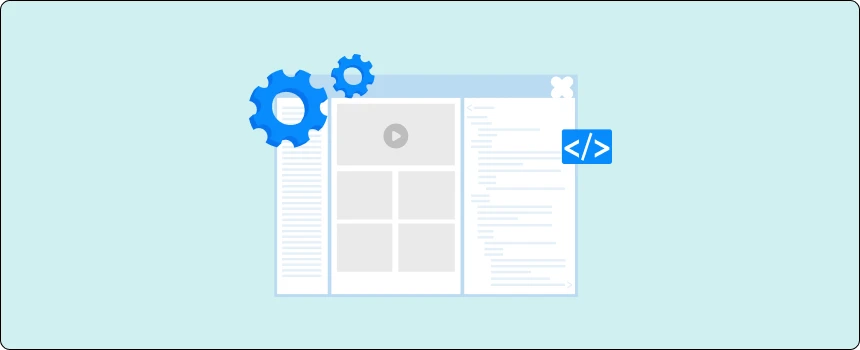Web development is a big field. When you start listening the words like frontend, backend and full stack, it can seem a little confusing. These words describe different roles, skills, and parts of creating a website or webapp.
Sites are more than online brochures; They are interactive tools that combines businesses with customers. To build them, you need people who can design the look, create a system and sometimes do both. This is the place where the roles of frontend, backend and full stack developers comes in.
In this blog, we’ll explain frontend vs backend vs full stack, what it means, how they work together, a comparison between them, and the skills that developers should know.
What is Frontend Development?

The frontend is the part of a website or app that the user can see and interact with. It’s the visual side, buttons, menus, colors, fonts, images, and layout. Everything you click, scroll, or type into is part of the frontend.
Technologies in frontend
Frontend developers use:
- HTML: The structure of the page
- CSS: Styling: Colours, fonts, layout
- JavaScript: Interactivity: dropdowns, animations, live updates
They also use frameworks and tools such as React, Vue, Angular, or Sass for styling to make websites responsive on different devices.
What does a frontend developer do?
A frontend developer:
- Builds the user interface (UI)
- Makes sure websites look good on desktop, tablet, and mobile
- Works on user experience (UX)
- Collaborates with designers
- Optimizes speed and usability
What is Backend Development?

Backend is the “behind the scenes” on a website. Users do not see this, but it handles the main features: to store data, running logic, connect to the databases and make sure everything works.
Technologies in the backend
Backend developers often use:
- Programming languages like Node.js, Python, Java, PHP, Ruby
- Frameworks like Express, Django, Flask, or Laravel
- Databases like MySQL, PostgreSQL, or MongoDB
- APIs that connect the frontend and backend
What does a backend developer do?
A backend developer:
- Builds systems to store and retrieve data
- Creates APIs for the frontend to use
- Manages user authentication and security
- Ensures the site can handle many users at once
- Keeps performance fast and reliable
What is Full Stack Development?

A full stack developer works on both frontend and backend. They can design the user interfaces, build server logic and connect to the database, basically handle the entire process from beginning to end.
Benefits of full stack
- They can take a project from idea to the end product.
- Perfect for startups or small teams with limited resources.
- They understand both sides, so communication is simple.
- Very flexible, can switch between tasks.
Challenges of full stack
- Requires learning a lot of technologies.
- Might not go as deep as a specialist would.
- Large, complex projects often need separate frontend and backend experts.
How Frontend and Backend Work Together
Frontend and backend must communicate. Usually, this happens through APIs.
Example:
- A user logs in with their username and password (frontend).
- The frontend sends this data to the backend via API.
- The backend checks if the credentials are correct.
- The backend sends a response.
- The frontend shows “Welcome” or “Wrong password.”
Neither can work alone. A website needs both.
Comparison: Frontend vs Backend vs Full Stack
Frontend, backend and full stack development are three main parts in web development. Each website or application plays a unique role in building a website or application. To understand the difference, let’s look at the comparison between them.
| Aspect | Frontend Development | Backend Development | Full Stack Development |
|---|---|---|---|
| Main Focus | User interface (what users see and interact with) | Server side logic, database, and system processes | Both frontend and backend |
| Key Technologies | HTML, CSS, JavaScript, React, Vue, Angular | Node.js, Python, PHP, Java, Ruby, MySQL, MongoDB | A combination of both frontend and backend tools |
| Typical Tasks | Design layout, styling, interactivity, and responsive design | Data storage, APIs, authentication, security, business logic | End to end development (UI + server + database) |
| Works With | Designers and UX teams | Servers, databases, APIs | Full workflow from design to deployment |
| Strengths | Visual appeal, usability, and user experience | Security, stability, data handling, scalability | Flexibility, faster prototyping, broader knowledge |
| Challenges | Cross browser issues, responsive design, accessibility | Handling complex logic, scaling systems, and performance | Requires mastering many technologies, with less specialization |
| Best for | Projects focused on design, branding and interactivity | Data heavy systems, complex apps, and secure platforms | Startups, small to medium projects, MVPs, or teams needing flexibility |
When to Choose Frontend, Backend or Full Stack
Each project does not require the same type of developer. The option depends on your goals, budget and complexity of your project.
Choose a frontend development if your project is more about how the site looks and feels like. This is the right choice when design, branding and user interaction are the main focus. For example, marketing websites, landing pages, portfolio,s and e-commerce stores require a strong visual effect. A frontend developer ensures that the user has a smooth navigation, fast load, and attractive layout.
Choose backend development If your project requires strong systems that work behind the scenes. It is best for apps that rely on databases, user accounts, payment or complex integration. Examples include bank or financial apps, booking engines, health portal or SaaS platform. A backend developer ensures that everything is safe, smooth and can handle growth.
Choose a full stack development if you want a developer to handle both frontend and backend. It works well for startups, small businesses, prototypes, or medium sized projects where costs and speed matters. Full Stack developers can build the entire product, from design to database, which saves time and budget. When you need flexibility or plan to scale later, they fit well.
Skills that Developers Need
Developers rely on many tools and libraries to make the work fast, safe and more organized. These devices reduce errors, improve teamwork, and help the sites run well in production.
For frontend
- HTML, CSS, JavaScript
- Responsive design
- Accessibility
- Browser compatibility
- Speed optimization
For backend
- Database design
- API development
- Security and authentication
- Scalability
- Deployment and server management
For full stack
- A mix of frontend + backend skills
- Ability to organize and balance both sides
- Knowledge of Git, testing, and CI/CD pipelines
Start Your Web Project with Nettsidedesign.no
A strong online presence starts with the right development choice. Nettsidedesign.no combines creativity and technical skills to create websites that attract visitors and keep them engaged. From easy to use design to powerful systems running in the background, we ensures that each part of your site works together.
We focus on creating websites that fit your business goals. With clear communication and a step by step process, we guide you from the plan to launch. If you want a website that provides results and supports your growth, you can contact us. We are ready to help.
Key Takeaways
- Frontend, backend and full stack are the three main roles in web development.
- Frontend developers focus on what users see and interact with on a website.
- Backend developers handle the systems, databases and logic that keep a website running.
- Full stack developers can work on both the frontend and backend of a project.
- Frontend work is best for design heavy and user focused projects.
- Backend work is best for complex systems and apps with strong data needs.
- Full stack development is best for small to medium projects or a start-up that requires flexibility.
- Each type of developer has different skills and tools to work with.
- Choosing the right developer depends on the size, goals, and budget of your project.
FAQs
What are HTML and CSS?
HTML (Hyper Text Markup Language) is used to create the structure of a web page, like text, headings and images. CSS (Cascading Style Sheets) is used to style the page, like colors, fonts and layouts. Together, they make a website look organized and attractive.
Which is better, a frontend or backend or full stack developer?
It depends on the project. Frontend is best for design and user interaction, backend is best for systems and data, and full stack is best if you want one person to handle both.
Is it better to learn frontend or backend?
Both are good choices. If you enjoy design and making things look good, frontend is a good path. If you like working with logic, data, and problem solving backend might be better. Many people later learn both and become full stack developers.
Is front end developer still in demand?
Yes, frontend developers are still in high demand. Businesses need websites and apps that look modern and give users a smooth experience, so frontend skills remain important.
Is C++ backend or frontend?
C++ is mainly used for backend development. It is often used in system programming, game engines and applications where speed and performance are important.






